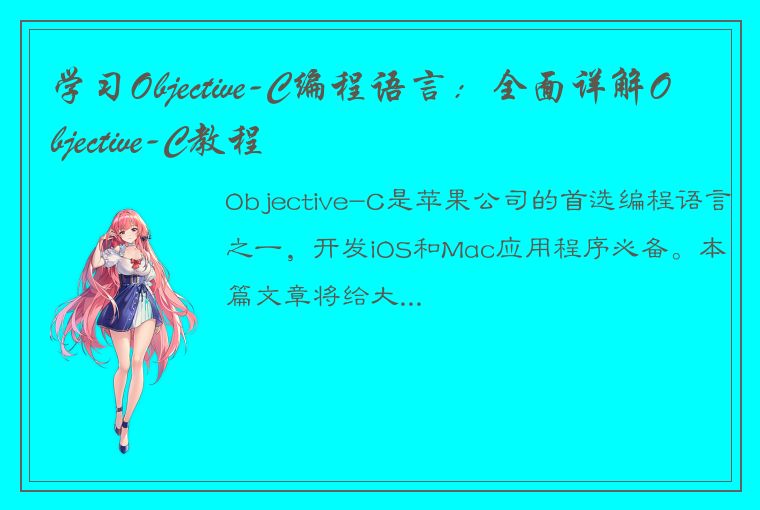Objective-C是苹果公司的首选编程语言之一,开发iOS和Mac应用程序必备。本篇文章将给大家带来一份完整的Objective-C教程,从基础语法开始,介绍到面向对象编程和高级主题。如果您是初学Objective-C的新手,请坐下来并准备好学习!

一、Objective-C基础语法
Objective-C是一种面向对象编程语言,与C语言兼容。学习Objective-C之前,必须掌握C语言的基础语法知识,因为它们有许多相同的语言构造。下面是Objective-C中的基础语法。
1.变量和数据类型
在Objective-C中,可以使用变量来保存值。变量有不同的类型,如整数,浮点数,字符和布尔等。以下是一些Objective-C变量类型的示例:
int myInt = 10;
float myFloat = 3.14;
char myChar = 'A';
BOOL myBool = YES;
2.控制流语句
Objective-C提供了许多控制流语句来控制程序的执行流程。以下是一些Objective-C控制流语句的示例:
if (myInt > 5) {
NSLog(@"myInt is greater than 5");
} else if (myInt == 5) {
NSLog(@"myInt is equal to 5");
} else {
NSLog(@"myInt is less than 5");
}
switch (myChar) {
case 'A':
NSLog(@"myChar is A");
break;
case 'B':
NSLog(@"myChar is B");
break;
default:
NSLog(@"myChar is not A or B");
break;
}
for (int i = 0; i < 10; i++) {
NSLog(@"%d", i);
}
3.函数和方法
函数和方法是Objective-C程序的基本构件。函数是一组语句,它们执行特定的任务,并可以返回值。方法是许多面向对象编程语言中的一个术语,表示特定对象的行为。以下是Objective-C函数和方法的示例:
int sum(int a, int b) {
return a + b;
}
- (void)sayHello {
NSLog(@"Hello, World!");
}
4.类和对象
Objective-C是一种面向对象编程语言,因此类和对象是非常重要的概念。类是一个定义对象的蓝图。对象是类的一个实例。以下是Objective-C类和对象的示例:
@interface MyClass : NSObject {
int myInt;
}
- (void)setMyInt:(int)newValue;
- (int)myInt;
@end
@implementation MyClass
- (void)setMyInt:(int)newValue {
myInt = newValue;
}
- (int)myInt {
return myInt;
}
@end
MyClass *myObject = [[MyClass alloc] init];
[myObject setMyInt:10];
NSLog(@"My int is %d", [myObject myInt]);
二、Objective-C面向对象编程
面向对象编程是Objective-C的核心。面向对象编程的主要思想是将程序组织成各种对象,每个对象都有自己的属性和方法。以下是一些Objective-C面向对象编程的示例:
1.继承
继承是面向对象编程的一个基本概念,它允许一个类继承另一个类的属性和方法。以下是Objective-C中继承的示例:
@interface MySubClass : MyClass
- (void)sayGoodbye;
@end
@implementation MySubClass
- (void)sayGoodbye {
NSLog(@"Goodbye, World!");
}
@end
MySubClass *mySubObject = [[MySubClass alloc] init];
[mySubObject setMyInt:20];
NSLog(@"My int is %d", [mySubObject myInt]);
[mySubObject sayHello];
[mySubObject sayGoodbye];
2.多态
多态是面向对象编程的另一个基本概念,它允许一个对象有多种形式。多态有两种类型:静态多态和动态多态。以下是Objective-C中多态的示例:
@interface MyParentClass : NSObject
- (void)sayHello;
@end
@implementation MyParentClass
- (void)sayHello {
NSLog(@"Hello from parent class!");
}
@end
@interface MyChildClass : MyParentClass
- (void)sayHello;
@end
@implementation MyChildClass
- (void)sayHello {
NSLog(@"Hello from child class!");
}
@end
MyParentClass *myParentObject = [[MyParentClass alloc] init];
[myParentObject sayHello];
MyChildClass *myChildObject = [[MyChildClass alloc] init];
[myChildObject sayHello];
3.封装
封装是面向对象编程的另一个基本概念,它允许对象隐藏其实现细节。Objective-C中使用@interface和@implementation关键字来实现封装。以下是Objective-C中封装的示例:
@interface MyEncapsulation : NSObject {
int myPrivateInt;
}
@property (nonatomic, assign) int myPublicInt;
@end
@implementation MyEncapsulation
@synthesize myPublicInt;
- (id)init {
self = [super init];
if (self) {
myPrivateInt = 10;
myPublicInt = 20;
}
return self;
}
@end
MyEncapsulation *myEncapsulationObject = [[MyEncapsulation alloc] init];
NSLog(@"My public int is %d", [myEncapsulationObject myPublicInt]);
三、Objective-C高级主题
Objective-C不仅限于基础语法和面向对象编程。它还包括一些高级主题,如异常处理和垃圾回收。
1.异常处理
异常处理是一种在程序运行期间处理错误的方法。Objective-C使用@try / @catch / @finally语法实现异常处理。以下是Objective-C中异常处理的示例:
@try {
// Some code that might throw an exception
}
@catch (NSException *exception) {
// Handle exception
}
@finally {
// Code that executes regardless of whether an exception was thrown
}
2.垃圾回收
垃圾回收是一种在程序运行期间自动处理内存管理的方法。Objective-C使用垃圾收集器来管理内存。以下是Objective-C中垃圾回收的示例:
@implementation MyClass
- (void)dealloc {
[super dealloc];
// Code that frees memory
}
@end
四、总结
本篇文章介绍了Objective-C的基础语法,面向对象编程和高级主题。Objective-C是一种非常强大的编程语言,因为它允许开发高性能和高质量的应用程序。如果您是iOS或Mac开发者,请务必掌握Objective-C!




 QQ客服专员
QQ客服专员 电话客服专员
电话客服专员